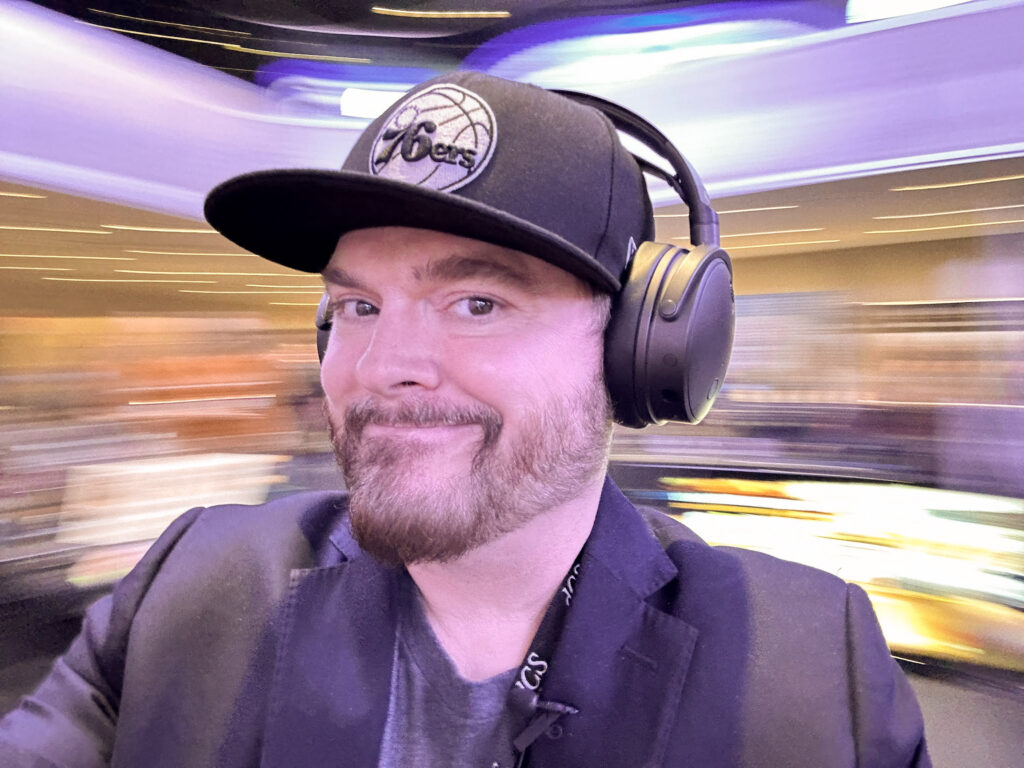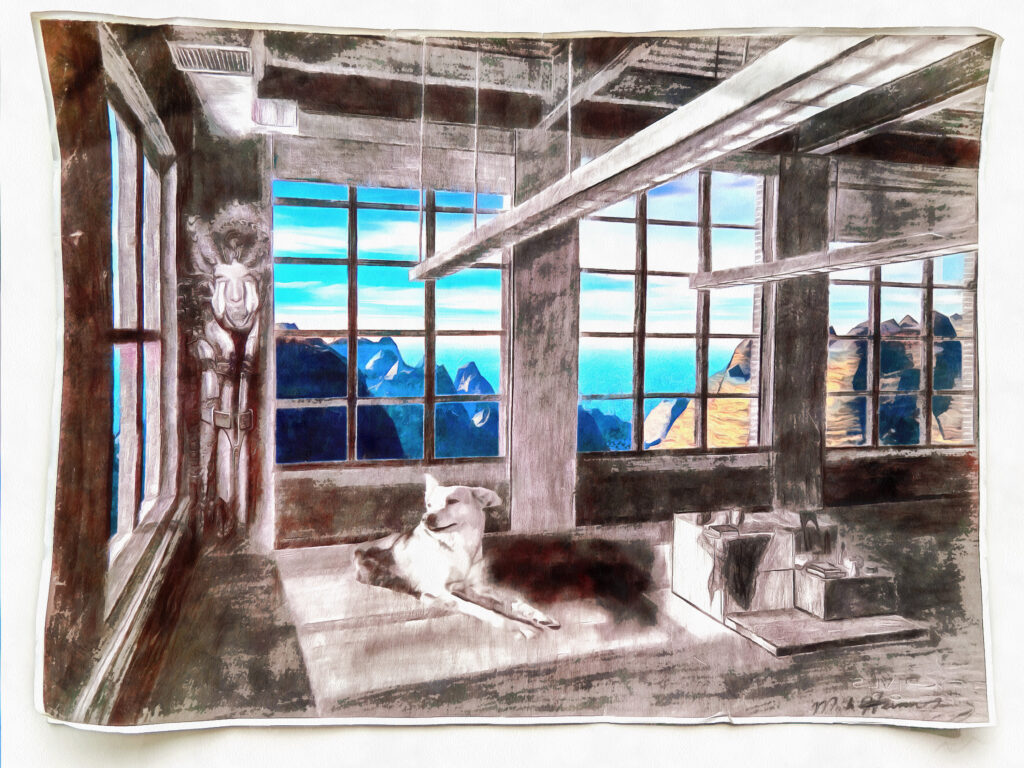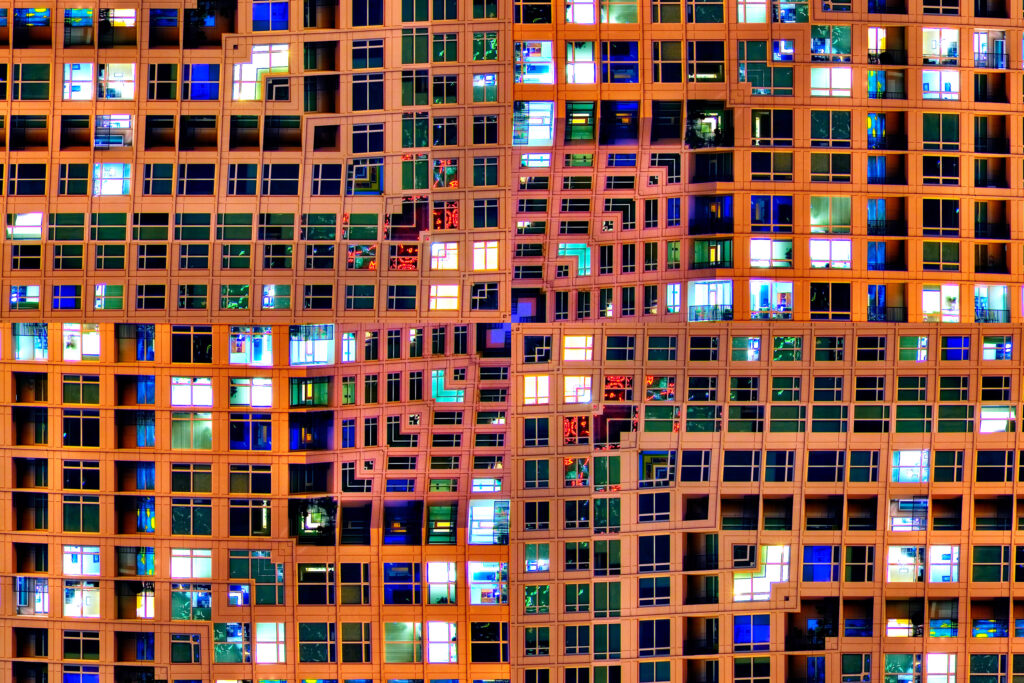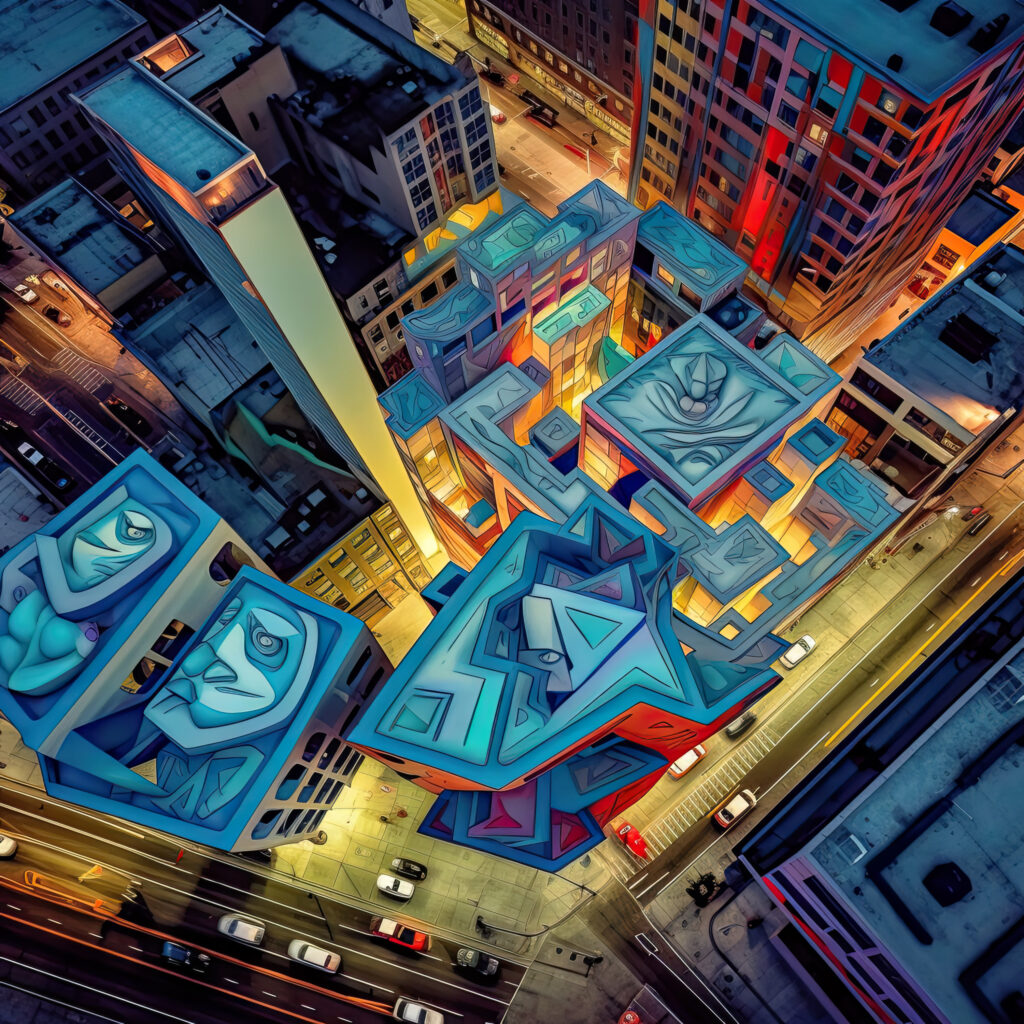Mark Henninger is a Philadelphia-based artist. His art uses psychedelic interplays of color, light, math and movement to reveal new and unique patterns of the universe.
The visual work Mark creates is the result of his wealth of experience with a camera, his embrace of new technologies like AI, the depth of his knowledge of graphics software, and his 30-year journey to push digital printing to its highest levels.
Born in New York City, Mark spent his childhood around the world in Africa and Europe. He returned to the United States to attend school and studied both traditional photography and computer graphics.
During the day, Mark is editor of Sound & Vision magazine, and founder/moderator of Audiophiles on a Budget, one of Facebook’s largest audio-visual discussion groups. In 1997 he founded the digital imaging firm Imagic Digital with his wife, Danya Henninger. He is a Level 10 Google Local Guide, and composes original music as Dub King.
Scroll down for a deeper history of Mark’s artistic journey, or read the AI-generated rap version here.

A Hasselblad and and a Commodore 64
When he was in 8th grade, a few years after moving back to the states with his mom, Mark got his first computer. He threw himself into learning the Commodore 64 machine inside and out, exploring how to use logic and its new GEOS (Graphic Environment Operating System) to achieve new and interesting visual results.
Photography followed a few years later. During his senior year at the Providence, R.I., arts magnet Central High School, Mark ended up with enough credits that he could spend most of his days concentrating on his photography elective. He was handed a manual Hasselblad film camera, and learned how to use it to capture scenes on film, then develop those images and print them on light-sensitive silver-halide paper.
By his early 20s, Mark was living in a loft in one of the oldest buildings in Providence with a roommate employed as Mayor Buddy Cianci’s photographer. On their second floor, the duo had set up a full-color darkroom to process their traditional photos. The trays of chemicals took up one side of the room, while at the back was a small Macintosh computer running Photoshop version 1.0.
That old Mac was put to work nearly every night, rendering fractals so Mark could meld the colorful imagery with scans of marijuana flowers, creating some of his first psychedelic-electronic art.
Imagic Digital and the quest for permanence
A few years later, after moving to South Jersey, setting up a network of Mac clones to experiment, and teaching himself Photoshop while his wife Danya learned Illustrator, Mark launched a digital imaging business, Imagic Digital.
The firm began as a service bureau for ad agencies and other professional photographers, providing Mark the excuse to become immersed in technical details involved in high-end scanning, image restoration and manipulation, and printing. One of Imagic’s most popular products turned out to be “photo-paintings” — portraiture turned oil painting by digital manipulation.
The was the late 1990s, however, and while inkjet printing was finally achieving photo-realism, it didn’t last. Achieving digital prints that didn’t fade became something of an obsession.
With typical enthusiasm, Mark plunged in up to the elbows, devising workarounds like rigging a fine-art plotter with syringes and tubes so it could use pigmented ink instead of the dye-based ink sold with it. He achieved minor notoriety (an article in the local paper, anyway), when he produced a method of digital printing his photographer clients deemed actually archival.

D1x, yachts, and a bit of schooling
The rise of digital photography seemed tailor-made for Mark — it combined his two earliest passions, computers and cameras.
Before the turn of the millennium, however, digital cameras available to the general public lacked in quality. To improve on the low sensor resolution, Mark became an expert in panoramic stitching, i.e. shooting a grid of images and combining them into a single seamless image of much higher resolution. These days, most cell phones can perform that task near- instantaneously, but two decades ago, it was a painstaking process.
He began marketing this service, which could turn out either large-scale still images or 360-degree virtual tours. These gigs ended up being Imagic’s entry point into offering photography services directly.
In 2001, when Nikon came out with the D1x, considered the one of the first digital cameras to have a sensor large enough to capture photos with magazine-quality resolution, Mark immediately bought one. It was enough to win his first pro photo job, shooting pics of a 118-foot mega yacht, which went well enough to open a whole new field.
Mark also decided some formal training would be useful, and took a drawing course at Richard Stockton College (he got an A), as well as a course in Photoshop (where the teacher resoundingly awarded him a grade of A++).

As he and Danya worked to build Imagic’s photography client roster, filling it with various yacht companies and expanding into hotel chains and golf resorts, Mark continued to use his ever-evolving toolkit to make art.
Wielding the same types of fractal-rendering software he’d used back in the Providence loft — Kai’s Power Tools, by now much faster and more evolved, as well as new 3D software like Bryce — Mark started producing unique digital images that incorporated photographs of the real world.
Falling for Philadelphia
After he and Danya moved to Philadelphia in 2005, to be closer to the airport that was Imagic’s connection to photo-video clients around the country and the Caribbean, Mark became interested in the patterns offered by his adopted home city, and began a series of image manipulations he dubbed “Philatextures.”
He made prints by the dozen, ending up with many more than he could hang at his home or office, and so ended up giving them away to friends and family. A few prints — usually the trippiest of the bunch — ended up in local boutiques.

After the architectural photography industry was rocked by the economic crash of 2008, Mark turned his focus to one of his other longtime fascinations — high-end audio and video.
He created a home theater in the top floor of his South Philly rowhouse, and spent hours and days and weeks in pursuit of the finest fidelity in both sound and screen, setting up and pulling apart and rebuilding speaker systems and projector screens and impossibly fragile large-screen TVs. His knowledge of color theory evolved from its print-centered origins and grew to include digital displays.
Soon after becoming a regular participant in AVS Forum, one of the internet’s earliest audio-visual discussion sites, Mark was hired to be its editor. This provided him with a continuous stream of the latest in display technology, and an excuse to keep his camera and computer equipment up to date. He also started Audiophiles on a Budget, which he still runs as one of Facebook’s largest audio discussion groups, with over 60,000 members.
He never stopped pursuing visual art, and when cell phone cameras became capable of high-quality capture, he started a few new side quests.
A million-photo challenge and the rise of AI
As Mark continued exploring Philadelphia, he realized many of the city’s small pocket parks weren’t showing up on Google Street View.
He began shooting photos and virtual tours of these green spaces and uploading them to Google Maps, joining the community of volunteer photographers contributing to the visual archive of the city. It became something of an obsession for Mark, who outfitted his scooter and Onewheel to be photo capture tools.
By autumn of 2019, he had posted more than 400,000 images to the platform. Four years later, he has achieved the highest ranking as a Google Local Guide (Level 10), and is closing in on half a billion views of his photos online.
Meanwhile, he built up a huge inventory of imagery of Philadelphia, just waiting for him to turn it into more digital art.
A creative breakthrough came in late 2022, when he discovered Midjourney. The generative artificial intelligence can be used create images from nothing but a worded prompt, but Mark put it to use manipulating his existing photos — using the AI bot as a tool much like one would wield a brush.

He set up a Discord server, and began feeding Midjourney pics of Philadelphia, along with instructions as to what direction he’d like the imagery to evolve. He tweaked settings and starting points, sometimes combining multiple photos and other times making his own changes before feeding the digital file to the algorithm.
After Mark deems the tweaking complete, he pulls the image out of Midjourney and applies additional filters and settings — via Photoshop and other software he’s familiar with from his years in digital imaging — that turn the bot’s low-res results into something detailed enough to become a high-resolution art print.
These final artworks are then giclee printed on canvas and watercolor paper in Mark’s home studio, completing a circle that started back in 1997, when he bought his first giant plotter.